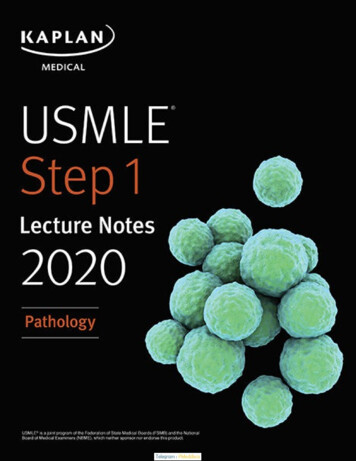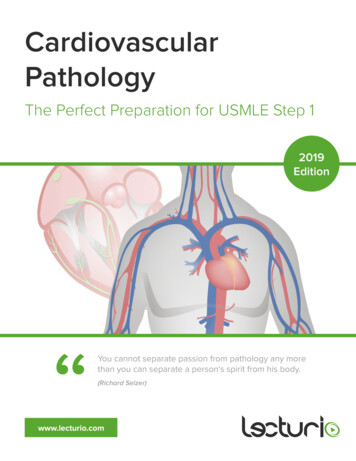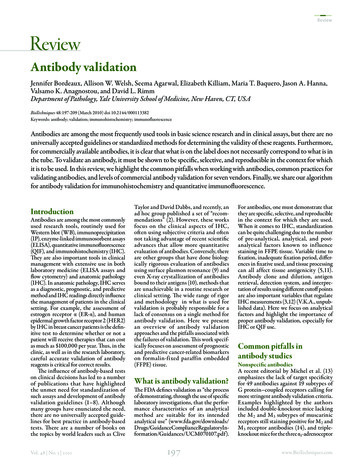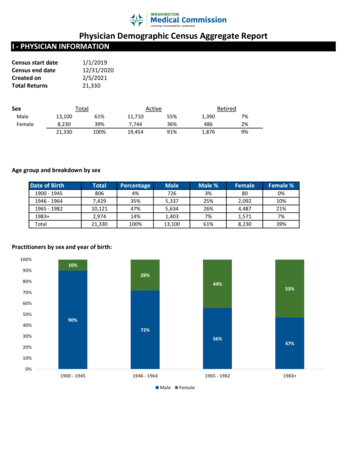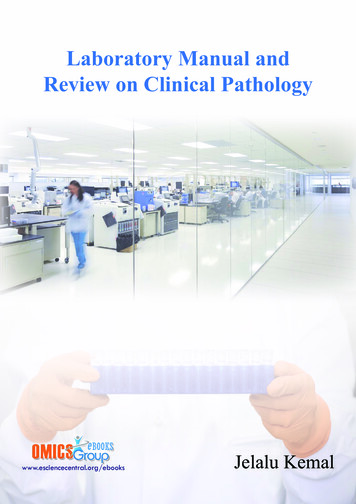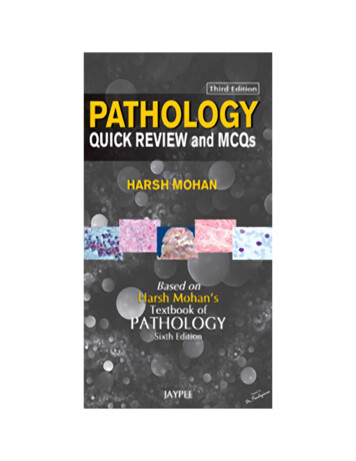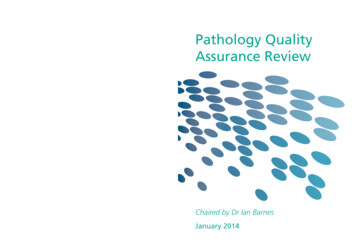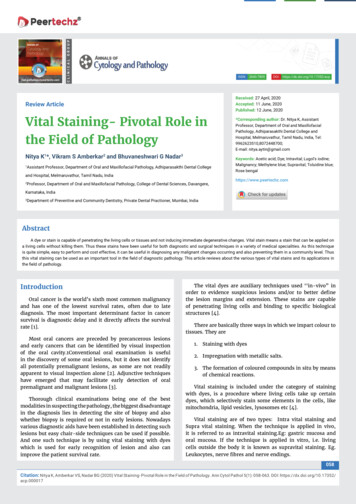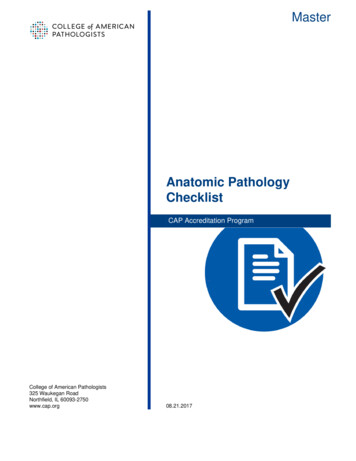
Transcription
MasterAnatomic PathologyChecklistCAP Accreditation ProgramCollege of American Pathologists325 Waukegan RoadNorthfield, IL 60093-2750www.cap.org08.21.2017
2 of 84Anatomic Pathology Checklist08.21.2017Disclaimer and Copyright NoticeOn-site inspections are performed with the edition of the Checklists mailed to a facility at the completionof the application or reapplication process, not necessarily those currently posted on the website. Thechecklists undergo regular revision and a new edition may be published after the inspection materialsare sent.For questions about the use of the Checklists or Checklist interpretation, email accred@cap.org or call800-323-4040 or 847-832-7000 (international customers, use country code 001).The Checklists used for inspection by the College of American Pathologists' Accreditation Programshave been created by the CAP and are copyrighted works of the CAP. The CAP has authorized copyingand use of the checklists by CAP inspectors in conducting laboratory inspections for the Commissionon Laboratory Accreditation and by laboratories that are preparing for such inspections. Except aspermitted by section 107 of the Copyright Act, 17 U.S.C. sec. 107, any other use of the Checklistsconstitutes infringement of the CAP's copyrights in the Checklists. The CAP will take appropriate legalaction to protect these copyrights.All Checklists are 2017. College of American Pathologists. All rights reserved.
3 of 84Anatomic Pathology Checklist08.21.2017Anatomic PathologyChecklistTABLE OF CONTENTSSUMMARY OF CHANGES.5INTRODUCTION. 7GENERAL ANATOMIC PATHOLOGY.7SAFETY.7SURGICAL PATHOLOGY. 8QUALITY MANAGEMENT. 8QUALITY CONTROL. 12SURGICAL SPECIMEN EXAMINATION.12INTRA-OPERATIVE CONSULTATION (RAPID DIAGNOSIS). 17FINE NEEDLE ASPIRATE (FNA) SPECIMENS. 19SURGICAL PATHOLOGY REPORTS. 20HISTOLOGY LABORATORY. 26GENERAL QUALITY CONTROL.27IMMUNOFLUORESCENCE MICROSCOPY. 29IMMUNOHISTOCHEMISTRY.29IN SITU HYBRIDIZATION (ISH).35PREDICTIVE MARKERS. 38DIGITAL IMAGE ANALYSIS (DIA). 44VALIDATION AND CALIBRATION (DIA). 45QUALITY CONTROL (DIA). 46SPECIMEN ANALYSIS (DIA).48DNA ANALYSIS (DIA). 48REPORTS (DIA). 49PERSONNEL (DIA). 50INSTRUMENTS AND EQUIPMENT. 50EX VIVO MICROSCOPY. 53PHYSICAL FACILITIES.54STORAGE AND SUPPLY.54HISTOLOGY LABORATORY SAFETY.55CIRCULATING TUMOR CELL ANALYSIS (CTC).58VALIDATION AND CALIBRATION (CTC). 58QUALITY CONTROL (CTC). 59SPECIMEN ANALYSIS (CTC).60REPORTS (CTC). 61PERSONNEL (CTC). 61FLOW CYTOMETRY DATA INTERPRETATION.62AUTOPSY PATHOLOGY. 65QUALITY MANAGEMENT. 65AUTOPSY CONSENT PROCEDURES. 66AUTOPSY ROOM. 67AUTOPSY PERFORMANCE AND DOCUMENTATION. 69AUTOPSY SAFETY. 73ELECTRON MICROSCOPY. 75
4 of 84Anatomic Pathology Checklist08.21.2017QUALITY CONTROL. 76ELECTRON MICROSCOPY SAMPLE PREPARATION. 76INSTRUMENTS AND EQUIPMENT.77REPORTS. 77RECORDS, FILES AND PHOTOGRAPHS.78LABORATORY SAFETY.78IN VIVO MICROSCOPY (IVM). 79DEFINITION OF TERMS. 80QUALITY MANAGEMENT AND VALIDATION.81IVM ANALYSIS. 82IVM REPORTS. 83
5 of 84Anatomic Pathology Checklist08.21.2017ON-LINE CHECKLIST AVAILABILITYParticipants of the CAP accreditation programs may download the checklists from the CAP website(www.cap.org) by logging into e-LAB Solutions. They are available in different checklist types and formattingoptions, including: Master — contains ALL of the requirements and instructions available in PDF, Word/XML or ExcelformatsCustom — customized based on the laboratory's activity (test) menu; available in PDF, Word/XML orExcel formatsChanges Only — contains only those requirements with significant changes since the previous checklistedition in a track changes format to show the differences; in PDF version only. Requirements that havebeen moved or merged appear in a table at the end of the file.SUMMARY OF CHECKLIST EDITION CHANGESAnatomic Pathology Checklist08/21/2017 EditionThe information below includes a listing of checklist requirements with significant changes in the current editionand previous edition of this checklist. The list is separated into three categories:1. New2. Revised: Modifications that may require a change in policy, procedure, or process for continuedcompliance; or A change to the Phase3. Deleted/Moved/Merged: Deleted Moved — Relocation of a requirement into a different checklist (requirements that have beenresequenced within the same checklist are not listed) Merged — The combining of similar requirementsNOTE: The listing of requirements below is from the Master version of the checklist. The customized checklistversion created for on-site inspections and self-evaluations may not list all of these requirements.NEW Checklist NP.30160ANP.34160Effective 201708/21/2017
6 of 84Anatomic Pathology ChecklistREVISED Checklist ve 2016DELETED/MOVED/MERGED Checklist ANP.23150ANP.29640Effective 201708.21.2017
7 of 84Anatomic Pathology Checklist08.21.2017INTRODUCTIONThis checklist is used in conjunction with the All Common (COM) and Laboratory General Checklists to inspectan anatomic pathology laboratory section or department.Laboratories that do not file slides on-site (e.g. "read-only" laboratories) must retain a sample of cases and allassociated slides on-site for review by the inspector on all days when the laboratory is subject to its regular onsite inspection. The sample must, at a minimum, include all cases and associated slides accessioned over acontinuous 2-week period within the previous 2 years.If telepathology is used by the pathologist to review slides or images for primary diagnosis, frozen sectiondiagnosis, formal second-opinion consultations, ancillary techniques in which the pathologist participates ininterpretation of images, or real-time evaluation of FNA specimens for triaging and preliminary diagnosis, referto the Telepathology and Remote Data Assessment section of the Laboratory General Checklist for additionalrequirements. Telepathology occurs when a pathologist views digitalized or analog video or still image(s), orother data files (e.g. flow cytometry files) at an off-site or remote location and an interpretation is renderedthat is included in a formal diagnostic report or recorded in the patient record. Requirements for remote dataassessment do not apply to testing performed within the laboratory using the laboratory's validated software(e.g. pathologist office using a network or virtual private network (VPN) connection).Note for non-US laboratories: Checklist requirements apply to all laboratories unless a specific disclaimer ofexclusion is stated in the checklist.GENERAL ANATOMIC PATHOLOGYDo NOT use this Checklist if the laboratory does NOT perform any on-site preparation or examination ofanatomic pathology specimens, but refers all submitted material to an outside laboratory, or if the laboratory'sinvolvement in anatomic pathology is limited to filing of reports and/or slides.SAFETYInspector Instructions: ANP.08216Sampling of formaldehyde and xylene vapor monitoring recordsFormaldehyde and Xylene SafetyPhase IIFormaldehyde and xylene vapor concentrations are maintained below the followingmaxima, expressed as parts per million, in all areas of the Anatomic PathologyDepartment where formaldehyde or xylene are used.NOTE: Formaldehyde and xylene vapor concentrations must be monitored in all areas wherethese reagents are used: e.g. surgical pathology gross dissection room, frozen section area,histology laboratory, autopsy room, etc. Xylene vapor concentration monitoring in histology
8 of 84Anatomic Pathology Checklist08.21.2017laboratories should include manual and automated coverslipping areas, as these locations areoften not ventilated. Initial monitoring involves identifying all employees who may be exposedat or above the action level or at or above the STEL and accurately determining the exposureof each employee identified. Further formaldehyde monitoring is mandated at least every sixmonths if results of the initial monitoring equal or exceed 0.5 ppm (8 hr time-weighted exposure,the “action level”) or at least once per year if the results exceed the short term exposure limit(STEL) 2.0 ppm. The laboratory may discontinue periodic formaldehyde monitoring if results fromtwo consecutive sampling periods taken at least seven days apart show that employee exposureis below the action level and the short-term exposure limit, and 1) no change has occurred inproduction, equipment, process or personnel or control measures that may result in new oradditional exposure to formaldehyde, and 2) there have been no reports of conditions that maybe associated with formaldehyde exposure.Formaldehyde monitoring must be repeated any time there is a change in production, equipment,process, personnel, or control measures which may result in new or additional exposureto formaldehyde for any employee involved in the activity. If any personnel report signs orsymptoms of respiratory or dermal conditions associated with formaldehyde exposure, thelaboratory must promptly monitor the affected person's exposure.Xylene must be monitored initially, but there is no requirement for periodic monitoring of xylene.Repeat monitoring should be considered when there is a change in production, equipment,process, personnel, or control measures likely to increase exposure levels.8 hr Time-WeightedExposure Limit in ppmAction Level( 8 hr TimeWeightedExposure)in ppm15 min Short-TermAverage ExposureLimit (STEL) in ppmFormaldehyde0.750.52.0Xylene100150Evidence of Compliance: Written policy for formalin and xylene safety including action limits, criteria for discontinuationof monitoring and criteria for resumption of monitoring AND Records of initial formalin and xylene monitoring and repeat monitoring when indicated AND Records of corrective action when exposure limits are exceededREFERENCES1) Montanaro A. Formaldehyde in the workplace and in the home. Exploring its clinical toxicology. Lab Med. 1996;27:752-7572) Goris JA. Minimizing the toxic effects of formaldehyde. Lab Med. 1997;29:39-423) Wenk PA. Disposal of histology stains. Lab Med. 1998;29:337-3384) Occupational Safety and Health Administration. 29CFR1910.1048 and 1450, revised July 1, 1998SURGICAL PATHOLOGYQUALITY MANAGEMENTMany technical and procedural quality control items are covered elsewhere in this Checklist. They are integralcomponents of comprehensive quality management and should be included within the defined program. Thissection determines if there is an active program of surveillance of the quality of surgical pathology activities,particularly the diagnostic reports. How this is accomplished depends upon the number of departmental staff,as well as the volume and type of diagnostic material. Such a program must include appropriate combinationsof activities such as the use of intra- and extra-departmental consultations, circulation of diagnostic material(random or by case type), periodic review of completed surgical pathology reports, and participation in selfassessment and performance improvement programs.
9 of 84Anatomic Pathology Checklist08.21.2017Inspector Instructions: Sampling of the following records: previous/current material review, intradepartmental consultations, extra-departmental consultations Does your laboratory exclude any specimen types from routine submission to thepathology department?What is your laboratory's course of action when a significant disparity exists betweenthe initial intra-operative consultation and final pathology diagnosis? **REVISED** 08/21/2017ANP.10016 Surgical Pathology ExclusionPhase IThere is a policy that lists specimens that an institution may choose to exclude fromroutine submission to the pathology department for examination, where applicable.NOTE: This policy should be made in conjunction with the hospital administration andappropriate medical staff departments and must be in compliance with national, federal, state,and local laws and regulations. The laboratory director should have participated in or beenconsulted by the medical staff in deciding which surgical specimens are to be sent to thepathology department for examination.The policy must comply with state or local laws. For example, the California Department ofHealth Care Services requires all tissues and objects removed during surgery to be submitted forpathology examination, unless a specific request is submitted to the state requesting a variance.This checklist item is not applicable if 1) all specimens are submitted to pathology, or 2) thelaboratory is not part of an institution that provides surgical services.REFERENCES1) Netser JC, et al. Value-based pathology: a cost-benefit analysis of the examination of routine and non-routine tonsil and adenoid2)3)4)5)ANP.10032specimens. Am J Clin Pathol. 1997;108:158-165Zarbo RJ, Nakleh RE. Surgical pathology specimens for gross examination only and exempt from submission. A College of AmericanPathologists Q-Probes study of current policies in 413 institutions. Arch Pathol Lab Med. 1999;123:133-139College of American Pathologists. Policies and guidelines manual. Surgical specimens to be submitted to pathology for examination.Northfield, IL: CAP, 1999:Appendix MJean Iacino. AFL 16-07, Program Flexibility Letter Recall. California Department of Public Health, State of California Health andHuman Services Agency. June 13, 2016.Nakhleh RE, Fitzgibbons PL, eds. College of American Pathologists. Quality improvement manual in anatomic pathology, secondedition. Northfield, IL: CAP, 2002Surgical Pathology Microscopic ExemptionsPhase IThere is a policy regarding what types of surgical specimens (if any) may be exempt frommicroscopic examination.NOTE: Irrespective of any exemptions, microscopic examination should be performed wheneverthere is a request by the submitting or attending physician, or at the discretion of the pathologistwhen indicated by the clinical history or gross findings. If there is such a policy, it should beapproved by the medical staff or appropriate committee. Typical exempt specimens includeforeskins in children, prosthetic cardiac valves without attached tissue, torn meniscus, varicoseveins, tonsils in children below a certain age, etc.REFERENCES1) Weibel E. Pathological findings of clinical value in tonsils and adenoids. Acta Otolaryngol. 1965;60:331-3382) Wolkomir AF, et al. Selective microscopic examination of gallbladders, hernia sacs and appendices. Am Surg. 1991:57:289-2923) Boutin P, Hogshead H. Surgical pathology of the intervertebral disc: is routine examination necessary? Spine. 1992;17:1236-12384) Cornell WB, Levin HS. The inguinal hernia sac: trash or treasure? Anatomic pathology II check sample, APII-9. Chicago, IL:American Society of Clinical Pathology, 1993:17(4)
10 of 84Anatomic Pathology Checklist5)6)7)8)ANP.1003808.21.2017Delong WH, Grignon DJ. Pathologic findings in ribs removed at the time of radical nephrectomy for renal cell carcinoma. Int J SurgPathol. 1994;1:177-180Raab SS. The cost-effectiveness of routine histologic examination. Am J Clin Pathol. 1998;110:391-396Zarbo RJ, Nakleh RE. Surgical pathology specimens for gross examination only and exempt from submission. A College of AmericanPathologists Q-Probes study of current policies in 413 institutions. Arch Pathol Lab Med. 1999;123:133-139College of American Pathologists. Policies and guidelines manual. Surgical specimens to be submitted to pathology for examination.Northfield, IL: CAP, 1999:Appendix MTissue Sample QualityPhase IIThere is a procedure that describes the process by which histotechnologists providefeedback to submitting pathologists and pathology assistants on the quality of the grosstissue sections received for tissue processing.NOTE: Inadequate fixation, overly thick tissue sections, non-decalcified bone, the presence ofstaples, etc., can lead to poor quality histologic sections and/or poor quality special stains/specialstudies.This requirement applies to both laboratories that gross tissue and perform all processingonsite, as well as laboratories that gross tissue and send it to another laboratory for processing,embedding, and sectioning (regardless of the outside laboratory's accrediting organization).Records of such feedback and corrective action taken when problems are identified may beincorporated into the laboratory's quality management program.Evidence of Compliance: Records of feedback and corrective action for problems identified with tissue qualityANP.10042Histologic Prep QualityPhase IThere is a written procedure that describes the process by which pathologists or theirdesignees provide feedback to the histology laboratory on the quality of histologicpreparations. This procedure must include the daily recording of the quality of thehistologic preparations for each day of tissue processing and slide preparation.NOTE: Histologic preparations refer to H & E sections, histochemical stains,immunohistochemistry preparations, and in situ hybridization preparations.This requirement applies to laboratories that process and interpret histologic preparations at thesame location, as well as laboratories that interpret histologic preparations processed at anotherlaboratory (regardless of that outside laboratory's accrediting organization).Records of such feedback and corrective action taken when problems are identified may beincorporated into the laboratory's quality management program.Specific quality control requirements for special stains, immunohistochemistry, and other specialstudies are found elsewhere in this checklist.Evidence of Compliance: Records of feedback and corrective action for problems identified with histologic prep qualityREFERENCES1) Department of Health and Human Services, Centers for Medicare and Medicaid Services. Clinical laboratory improvementamendments of 1988; final rule. Fed Register. 2003(Jan 24): [42CFR493.1273(a)].ANP.10050Previous/Current Material ReviewPhase IIWhenever appropriate, pertinent previous cytologic and/or histologic material from thepatient is reviewed with current material being examined.NOTE: Because sequential analysis of cytologic and histologic specimens may be critical inpatient management and follow-up, efforts must be made to routinely review pertinent previousmaterial. Records of the retrospective review should be included in the current patient report.
11 of 84Anatomic Pathology Checklist08.21.2017REFERENCES1) Bozzo P. Implementing quality assurance. Chicago, IL: American Society of Clinical Pathology, 1991:72-74ANP.10100Intra-operative/Final Diagnosis DisparityPhase IIWhen significant disparity exists between initial intra-operative consultation (e.g. frozensection, intra-operative cytology, gross evaluation) and final pathology diagnosis, it isreconciled and recorded in the surgical pathology report and in the departmental qualitymanagement file.REFERENCES1) Gephardt GN, Zarbo RJ. Interinstitutional comparison of frozen section consultations. A College of American Pathologists Q-Probes2)3)ANP.10150study of 90 538 cases in 461 institutions. Arch Pathol Lab Med. 1996;120:804-809Nakhleh RE, Zarbo RJ. Amended reports in surgical pathology and implications for diagnostic error detection and avoidance. ACollege of American Pathologists Q-Probes study of 1 667 547 accessioned cases in 359 laboratories. Arch Pathol Lab Med.1998;122:303-309Firlik KS, et al. Use of cytological preparations for the intraoperative diagnosis of stereotactically obtained brain biopsies: a 19yearexperience and survey of neuropathologists. J Neurosurg. 1999;91:454-458Intra and Extra-Departmental ConsultationsPhase IThe laboratory has a procedure for handling intra- and extra-departmental consultationsin the patient's final report.NOTE: Intra-departmental consultations may be included in the patient's final report, or filedseparately. The pathologist in charge of the surgical pathology case must decide whether theresults of intra-departmental consultations provide relevant information for inclusion in somemanner in the patient's report.Records of extra-departmental consultations must be readily accessible within the pathologydepartment. The method used to satisfy this requirement is at the discretion of the laboratorydirector, and can be expected to vary according to the organization of the department. Theseconsultations can be maintained with the official surgical pathology reports or kept separately, solong as they can be readily linked.REFERENCES1) Leslie KO, et al. Second opinions in surgical pathology. Am J Clin Pathol. 1996;106(suppl 1):S58-S642) Tomaszewski JE, et al. Consensus conference on second opinions in diagnostic anatomic pathology. Who, what, and when. Am J3)4)5)6)ANP.10250Clin Pathol. 2000;114:329-335Hahm GK, et al. Quality assurance of second opinion in gastrointestinal and liver pathology. Am J Clin Pathol. 2000;114:631Renshaw AA, et al. Blinded review as a method of quality improvement in surgical pathology. Arch Pathol Lab Med.2002;126:961-963Azam M, Nakhleh RE. Surgical pathology extradepartmental consultation practices. A College of American Pathologists Q-probesstudy of 2746 consultations from 180 laboratories. Arch Pathol Lab Med. 2002;126:405-412Cooper K, et al. Institutional consultations in surgical pathology. How should diagnostic disagreements be handled? Arch Pathol LabMed. 2002;126:650-651Extra-Departmental ConsultationPhase IWhen extra-departmental cases are submitted to the laboratory for consultation, they areaccessioned according to the standard practices of the laboratory, and a final pathologyreport is prepared, with a copy sent to the originating laboratory.NOTE: In most cases, original materials including slides and blocks should be promptly returnedto the original institution. However, in some situations (for example, when the patient is receivingongoing care at the referral institution pending tumor resection, etc.) it may be appropriate for thereferral laboratory to retain slides/blocks for a period of time. In such situations, a letter shouldbe sent to the originating laboratory along with the consultation report, requesting permission to
an anatomic pathology laboratory section or department. Laboratories that do not file slides on-site (e.g. "read-only" laboratories) must retain a sample of cases and all associated slides on-site for review by the
